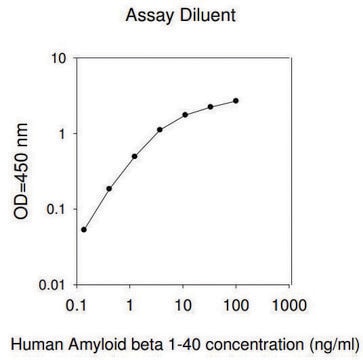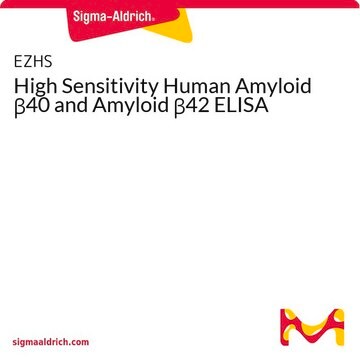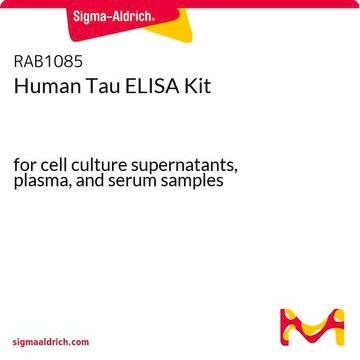推荐产品
product name
High Sensitivity Human Amyloid β40 ELISA, This High Sensitivity Human Amyloid β40 ELISA is used to measure & quantify Amyloid β40 levels in Neuroscience research.
品質等級
物種活性
human
包裝
kit of 1 × 96 wells
參數
50 μL sample volume (Overnight assay)
assay range
sensitivity: 6.0 pg/mL
(50 μl sample size)
standard curve range: 16-500 pg/mL
技術
ELISA: suitable
輸入
sample type plasma (K2 EDTA)
sample type serum
sample type cerebrospinal fluid (CSF)
應用
research use
檢測方法
colorimetric (450nm/590nm)
運輸包裝
wet ice
儲存溫度
2-8°C
基因資訊
human ... APP(351)
一般說明
Amyloid beta peptides have been implicated in the etiology of Alzheimer’s disease. Amyloid beta 40 is the most prominent peptide and Amyloid beta 42 is the neurotoxic form. The Amyloid beta 42/40-ratio (AB ratio) has been reported as a better indicator of the Alzheimer pathology. Millipore’s High Sensitivity Human Amyloid β40 ELISA kit is used for the measurement of Amyloid β40 in cerebrospinal fluid, cell culture supernatants, primary neurons and plasma in a 96-well format.
特異性
The Amyloid β40 ELISA (HS) uses monoclonal anti-Aβ antibodies with high selectivity for human Aβ. The capture antibody recognizes the C-terminal end of Amyloid β1-40, which causes a high selectivity for Aβ 40. The cross-reactivity of the used antibodies to other Amyloid peptides was tested by ELISA and BIACORE and shows no significant cross-reactivity to Aβ1-38, Aβ1-39, Aβ1-42, Aβ1-43 and Aβ1-44.
應用
Research Category
Neuroscience
Neuroscience
Research Sub Category
Alzheimer′s Disease
Alzheimer′s Disease
This High Sensitivity Human Amyloid β40 ELISA is used to measure & quantify Amyloid β40 levels in Neuroscience research.
This assay requires 50 µl of sample (cerebrospinal fluid, cell culture supernatants, primary neurons, or plasma) and is an overnight assay.
Used to detect/quantify: Amyloid β40
儲存和穩定性
Components in the kit can be stored up to 2 weeks at 2-8°C
其他說明
Please contact Technical Service for linearity of dilution.
免責聲明
For research use only. Not for use in diagnostic procedures.
推薦
产品编号
说明
价格
訊號詞
Warning
危險聲明
危險分類
Aquatic Chronic 3 - Met. Corr. 1 - Skin Sens. 1
儲存類別代碼
8A - Combustible corrosive hazardous materials
Kendra L Puig et al.
Journal of Alzheimer's disease : JAD, 44(4), 1263-1278 (2014-11-20)
Alzheimer's disease (AD) is a neurodegenerative disorder histologically characterized by amyloid-β (Aβ) protein accumulation and activation of associated microglia. Although these features are well described in the central nervous system, the process and consequences of Aβ accumulation in the enteric
Mariya V Hrynchak et al.
Frontiers in synaptic neuroscience, 12, 16-16 (2020-05-12)
Alzheimer's disease is regarded as a synaptopathy with a long presymptomatic phase. Soluble, oligomeric amyloid-β (Aβ) is thought to play a causative role in this disease, which eventually leads to cognitive decline. However, most animal studies have employed mice expressing
Anna Bogstedt et al.
Journal of Alzheimer's disease : JAD, 46(4), 1091-1101 (2015-09-25)
Utilizing decision making biomarkers in drug development requires thorough assay validation. Special considerations need to be taken into account when monitoring biomarkers using immunoassays in the presence of therapeutic antibodies. We have developed robust and sensitive assays to assess target
Gunjan Manocha et al.
Current Alzheimer research, 15(12), 1123-1135 (2018-08-03)
Alzheimer's disease (AD) is associated with age-associated central nervous system degeneration and dementia. This decline in the function correlates with deposition of Aβ peptide containing plaques and associated reactive gliosis. The inflammatory phenotype of microglia, in particular, is often considered
Nataliya Golovyashkina et al.
Molecular neurodegeneration, 10, 60-60 (2015-11-07)
Dendritic simplification, a key feature of the neurodegenerative triad of Alzheimer's disease (AD) in addition to spine changes and neuron loss, occurs in a region-specific manner. However, it is unknown how changes in dendritic complexity are mediated and how they
我们的科学家团队拥有各种研究领域经验,包括生命科学、材料科学、化学合成、色谱、分析及许多其他领域.
联系技术服务部门








